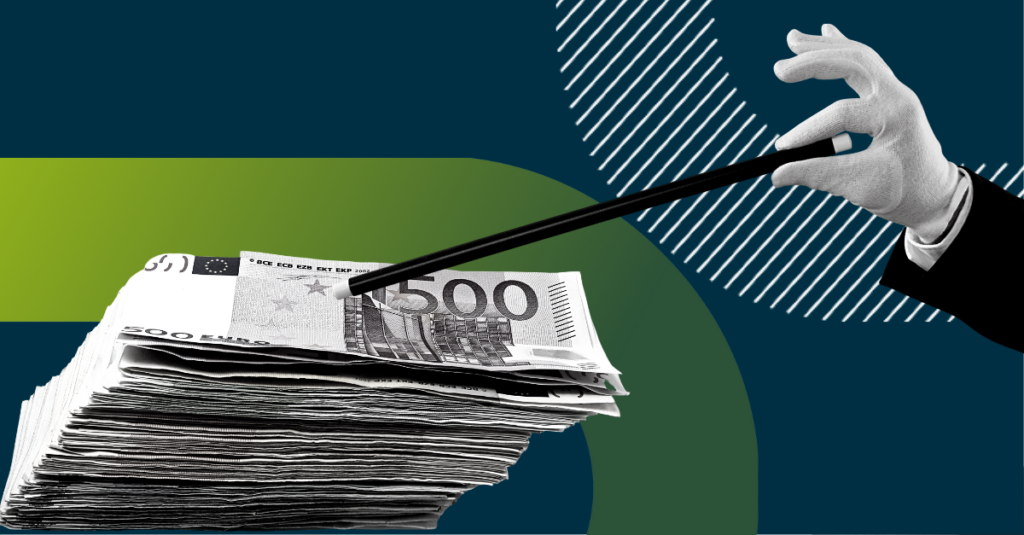Michael was stumped. In his thirty years as a manager, business lead, and now CEO for a well-established company, he’d weathered many storms.
But none like this. His company was under intense pressure—and the weight was beginning to feel unbearable.
6 months ago, the firm’s once-steady cash flow had started to become inconsistent. No problem, he thought, these ups and downs are commonplace in the industry. They usually resolved themselves in a quarter or so, so he didn’t think much of it.
Except, they didn’t. The next quarter was even worse. Michael realized this wasn’t a momentary downturn, so he did some deeper digging. Not only had the company been losing customers on an unusually large scale, but they’d also lost one of their biggest, most loyal accounts last week.
This was an alarming wake-up call. Michael realized the company had been coasting for too long. It had rested on its laurels, hoping its once-novel products were enough to keep customers happy.
Only, they weren’t. The competition had caught up with their products and overtaken them operationally. They were digital-first and agile, with tech-savvy teams committed to pushing the boundaries of what’s possible.
Michael’s company, on the other hand, had become comfortable with its legacy IT operations that also included a lot of manual effort. Worse still, their team appeared resistant to change. “If it ain’t broke, don’t fix it”, they’d say. Only, it was now officially broken.
He knew they needed to revolutionize their operations—but this task seemed Herculean. So, he put this idea to one side and tried as hard as possible to plough on ahead with their existing tools, systems, and mindset.
Table of Contents

Nothing changed. Well, except his ability to sleep. Michael would spend hours staring at the ceiling, a single word echoing in his mind: “Digitize!”
But how?
Then, just as he was about to reach breaking point, inspiration struck.
One morning, as he was having his routine cup of coffee and reading the paper, he stumbled upon an article about the magic of recurring revenue in the modern business landscape. Intrigued, he read on.
The article explained how some of the world’s most successful businesses succeeded thanks to their flexible, digital-first business models, designed around customers’ needs. This was a far cry from how Michael’s company had operated.
It had always set the rules and expected customers to follow along. Nowadays, however, the roles have reversed. Customers were in charge—and businesses needed to adapt according to what they wanted.
Michael scoffed at the idea of presenting this to his board. They might be in a crisis, but surely this didn’t mean they’d have to rip up the rulebook and start from scratch?
But then he thought about the payoffs: recurring revenue and long-term loyalty. Could this be the strategy that the company needed to turn around its fortunes?
The more he read, the more it made sense. Recurring revenue models, the article explained, offered not only predictable, reliable income, but also increased the value of the company. This steady cash flow would dramatically reduce the financial uncertainty plaguing his business and boost the company’s market value. And if a customer-centric approach such as an innovative usage-based component were also included, this would strengthen customer relationships and expand revenue streams.
Additionally, it would provide the much-needed capital to invest in modernizing their product offerings and recapturing their market share. However, the article also cautioned about the difficulties of transition, the need to adopt new technologies, and the challenge of shifting customer expectations.
Michael was unsure what to do next—so he decided to conduct some further research into how today’s most successful businesses operate.
He thought about an ex-colleague called Anna who moved to Berlin to start her own SaaS company. He’d recently seen a LinkedIn post that her company had raised Series B funding.
So he sent Anna a text congratulating her on the funding round and cheekily asking if she’d be willing to share her secrets of success.
Learn more about our Recurring Revenue Solutions
Recurring Billing
Discover how our robust billing automation helps you to scale any recurring revenue business model
Subscription Management
Build any digital business model with our flexible plans, options, and pricing configurations

“She must be doing something right”, he thought, and sent her a text
“She must be doing something right”, he thought, so he sent Anna a text congratulating her on the funding round and cheekily asking if she’d be willing to share her secrets of success.
A few hours later, his phone pinged. She’d responded. He expected a polite “Thanks for your message, hope you’re well”, but when he opened it, it read like a business seminar.
Anna explained how her company had been languishing until it decided to operate a customer-centric subscription business model, charging customers based on how they used the service.
She went on to explain how this one change had revolutionized their monthly recurring revenue and annual recurring revenue. Customers said they felt better catered for, and like the company put their interests before its own.
Suddenly, they were attracting their competitors’ most loyal customers in droves.
Michael was shocked. How did a startup that was only a few years old implement a business model that his company could only dream of? Soon enough, he found out the answer.
Anna explained how they created an IT infrastructure that could handle their new customer-centric business model while enabling automation and scalability. At the heart of their system, they implemented a smart subscription management platform that seamlessly integrated with the company’s backend systems, allowing her finance team to manage subscriptions, handle automatic renewals, implement flexible pricing strategies, and create subscription and usage-based invoices in one place.
From what Michael could tell, such a highly automated IT system supporting innovative customer-centric business models was the magic wand that transformed Anna’s company from a struggling startup to a star scaleup.
From what Michael could tell, such a highly automated IT system supporting innovative customer-centric business models was the magic wand that transformed Anna’s company from a struggling startup to a star scaleup.
It was designed to handle the rigors of dynamic pricing strategies, global transactions, and real-time data analysis. It was the digital solution Michael had been seeking, a vehicle that could ferry his company into the era of modern recurring revenue and usage-based pricing.
Michael knew what he needed to do: enhance the company’s existing legacy IT architecture to pave the way for the introduction of a new innovative subscription and usage-based business model.
However, he realized this wasn’t going to be an easy journey. The implementation process would take considerable time and effort, not to mention some money. There would be resistance, roadblocks, and perhaps even failures along the way.
But it would be worth the leap if he could boost customer retention and unlock a stable, recurring revenue stream.
The next day, Michael presented the idea to his board. They were hesitant at first—but Michael was adamant this was the only way forward. Due to Michael’s passionate speech and the more than convincing arguments, they agreed on the project.
Michael then gathered his team and presented his vision: to revitalize the business by adopting a digital-first recurring revenue model combined with usage-based elements. He could tell they were hesitant. Soon enough, hushed, alarmed whispers spread through the room.
Undeterred, he plowed on with his speech. Michael presented how a state-of-the-art monetization and billing platform could enhance their existing IT infrastructure, explaining how the platform worked, could be easily integrated via API within a couple of months, and described how it had almost single-handedly saved Anna’s business.
Suddenly, there was no more panicked whispering. He’d caught their attention.
Were they totally convinced? Not exactly. The idea of automating accounts receivables (AR) processes, analyzing real-time data, creating customized invoices, and managing subscriptions and pay-per-use at scale seemed too good to be true.
But most importantly, they were willing to try.
The first step was to strategize how they would begin this transition, and how to communicate their new approach to their existing customer base. This was an essential but tricky step, as they had to balance the benefits of the new model without alienating their loyal customers.
Fortunately, this was easier than they thought. Customers loved the idea of only paying for what they used. Many mentioned that they were growing tired of paying a flat rate for a tool that, while valuable, they didn’t use all too often. Even those who used the tool day in, day out understood that this pricing model made more sense.
Everyone was surprisingly receptive. Of course, Michael knew the mood would soon sour if the company ran into hitches that affected customers’ service.
Transitioning to a recurring revenue business model that features usage-based pricing elements wasn’t without its hiccups. Adjusting to the technological change initially proved challenging, but the user-friendly interface and excellent customer support of the subscription management platform company made the transition and learning curve manageable.
The team quickly adapted to the new system. In no time, they were creating and sending customized and highly individual invoices with ease at a large scale. And as they began automating their previously time-consuming manual processes, everyone seemed happier and more productive, and the mood lifted around the office.
Most importantly of all, customers were happy—and the results soon started to pour in.

Within a few months, the magic of recurring revenue started to show its worth.
Within a few months, the magic of recurring revenue started to show its worth. Cash flow was more predictable, allowing the business to invest confidently in new product development and market expansion. The customer churn rate dropped significantly, and new customers were subscribing at a rate they had never seen before.
The business was finally catching up to the modern age.
What’s more, they started to use their customers’ data to improve their own operations. The subscription management platform’s real-time data analysis gave them invaluable insights into customer behavior, product performance, and market trends.
This newfound understanding of their business allowed them to create better products and roll out more targeted marketing campaigns, which helped further boost the company’s bottom line.
In the end, Michael’s courage to embark on this monetization project saved his company. The transition to new customer-centric business models re-engaged their existing customers, attracted a new customer base, and stabilized their cash flow.
Not only did the business regain its lost market share, but it also positioned itself as an innovative leader in its industry.
The journey wasn’t always easy. The initial resistance, the learning curve, and the challenge of transitioning existing customers to the new model were substantial hurdles. But the benefits far outweighed these temporary inconveniences. A few months ago, his company was struggling to survive. Now, it was thriving.
By partnering with the right technology partner, Michael and his company harnessed the magic of recurring revenue and usage-based business models, powering their business forward in the modern era.
Looking back at his journey, Michael often wonders how different things would have been had he not come across that article about recurring revenue. Today, his company is a beacon for other traditional businesses, a testament to the transformative potential of digitization and recurring revenue and pay-per-use models.
And he hasn’t stopped telling his network about the power of it.

